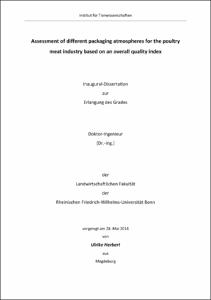Assessment of different packaging atmospheres for the poultry meat industry based on an overall quality index

Assessment of different packaging atmospheres for the poultry meat industry based on an overall quality index

| dc.contributor.advisor | Kreyenschmidt, Judith | |
| dc.contributor.author | Herbert, Ulrike | |
| dc.date.accessioned | 2020-04-19T09:53:24Z | |
| dc.date.available | 2020-04-19T09:53:24Z | |
| dc.date.issued | 10.11.2014 | |
| dc.identifier.uri | https://hdl.handle.net/20.500.11811/5861 | |
| dc.description.abstract | The objective of this thesis was the development of an Overall Quality Index (OQI) for modified atmosphere packaged (MAP) poultry fillets to compare and to assess the influence of different environmental factors on the quality loss. In particular, the influence of different temperature conditions and different oxygen combinations on the composition of the specific spoilage flora (Brochothrix thermosphacta, Pseudomonas spp., Enterobacteriaceae, Lactobacillus spp.) and sensory parameters was investigated. Furthermore, a comparison was made between oxygen enriched and nitrogen enriched atmospheres, which are the atmospheres typicially used by the industry for fresh poultry fillet. A special focus was laid on the growth of Listeria monocytogenes and the interaction with specific spoilage organisms. The influence on quality loss by the noble gas argon as an alternative to nitrogen was also tested. The development of the microbiological and sensory parameters was modeled by using the Gompertz function. Based on the obtained results, an Overall Quality Index (OQI) was developed, allowing a comparison and assessment of the different influence factors on the quality loss. The storage trials showed that the quality loss is strongly influenced by changing environmental conditions, and no specific spoilage organisms (SSO) could be identified to compare and assess the effect of different environmental factors. Generally, the results showed that the temperature conditions and the oxygen content variation had a strong influence on the composition of the microflora and on the quality loss. 55-60% oxygen combined with low temperature decreased microbial growth and the sensory quality loss. The comparison between the oxygen free and the oxygen enriched atmosphere on the growth of L. monocytogenes showed that the oxygen enriched atmosphere was most effective at suppressing the growth. Argon, as a novel packaging gas, had no additional effect on the growth of typical spoilage microorganisms. However, using 15% Ar seems to have a beneficial effect on meat color. The developed OQI showed that low storage temperature (<4°C) and 60% O2/25% CO2, with 15% N2 or 15% Ar, had the main beneficial effect on the quality loss. The developed index can be used to support the decision making process of meat companies for a reliable and standardized comparison between the influence of different environmental parameters on the quality loss of fresh poultry fillet. Thus, the application of the OQI will support the process of delivering high quality products and will reduce food waste at the same time. | en |
| dc.description.abstract | Bewertung unterschiedlicher Gaszusammensetzungen für die Geflügelfleischindustrie auf Grundlage eines Gesamtqualitätsindex Das Ziel der vorliegenden Arbeit war die Entwicklung eines Gesamtqualitätsindex (OQI) für unter Schutzgas verpacktes (MAP) Geflügelfleisch, um den Einfluss verschiedener Umweltfaktoren auf die Haltbarkeit und den Qualitätsverlust standardisiert zu bewerten. Zunächst wurde der Einfluss der Temperatur und unterschiedlicher Sauerstoffkonzentrationen auf die Entwicklung spezifischer Verderbskeime (Brochothrix thermosphacta, Pseudomonas spp., Enterobacteriaceae, Lactobacillus spp.) und sensorische Parameter untersucht. Weiterhin wurde die Entwicklung der Qualitätsparameter unter Hochsauerstoff und -stickstoff angereicherten Atmosphären verglichen. Insbesondere galt es dabei den Einfluss der Gasgemische auf das Wachstum von Listeria monocytogenes zu untersuchen. Des Weiteren wurde der Einfluss des Edelgases Argon getestet. Die Entwicklung der unterschiedlichen Parameter wurde mit dem modifizierten Gompertz Model modelliert. Basierend auf den Ergebnissen wurde ein Gesamtqualitätsindex entwickelt, der mikrobiologische und sensorische Parameter miteinander kombiniert. Aus den jeweiligen Lagertests ging hervor, dass die Keimflora signifikant von den jeweiligen Umweltbedingungen beeinflusst wurde. Somit konnte kein spezifischer Verderbsorganismus (SSO) identifiziert werden, der allein einen standardisierten Vergleich der unterschiedlichen Einflussfaktoren ermöglichte. Sowohl die Temperatur als auch die Variation der Sauerstoffkonzentration zeigte einen starken Einfluss auf die Entwicklung der Verderbsflora und der sensorischen Parameter. 55-60% Sauerstoff in Kombination mit niedrigen Lagertemperaturen reduzierten die Wachstumsgeschwindigkeit der mikrobiologischen und sensorischen Parameter. Der Vergleich zwischen Sauerstoff und Stickstoff zeigte, dass die Sauerstoffatmosphäre am effektivsten das Wachstum von L. monocytogenes unterdrückte. Argon wies keinen zusätzlichen Effekt auf den Qualitätsverlust auf. Allerdings zeigte das mit 15% Ar angereichte Gasgemisch bei einigen Proben eine positive Wirkung auf die Fleischfarbe. Aus dem entwickelte OQI ging hervor, dass niedrige Lagertemperaturen (<4°C) und 60% O2/25% CO2 mit 15% Ar oder 15% N2 den Qualitätsverlust maßgeblich reduzierten. Der QQI kann bei qualitätsrelevanten Entscheidungsprozessen der Industrie ein wichtiges Hilfsmittel darstellen, um den Einfluss unterschiedlicher Faktoren auf den Qualitätsverlust von Geflügelfilet standardisiert zu vergleichen und zu bewerten. Langfristig können dadurch die Qualität und Sicherheit von frischem Geflügelfleisch verbessert und gleichzeitig die Menge an Ausschüssen reduziert werden. | en |
| dc.language.iso | eng | |
| dc.rights | In Copyright | |
| dc.rights.uri | http://rightsstatements.org/vocab/InC/1.0/ | |
| dc.subject | Schutzgasverpackungen | |
| dc.subject | Geflügelfleisch | |
| dc.subject | Haltbarkeit | |
| dc.subject | Modellierung | |
| dc.subject | Qualitätsindex | |
| dc.subject.ddc | 620 Ingenieurwissenschaften und Maschinenbau | |
| dc.title | Assessment of different packaging atmospheres for the poultry meat industry based on an overall quality index | |
| dc.type | Dissertation oder Habilitation | |
| dc.publisher.name | Universitäts- und Landesbibliothek Bonn | |
| dc.publisher.location | Bonn | |
| dc.rights.accessRights | openAccess | |
| dc.identifier.urn | https://nbn-resolving.org/urn:nbn:de:hbz:5n-37743 | |
| ulbbn.pubtype | Erstveröffentlichung | |
| ulbbnediss.affiliation.name | Rheinische Friedrich-Wilhelms-Universität Bonn | |
| ulbbnediss.affiliation.location | Bonn | |
| ulbbnediss.thesis.level | Dissertation | |
| ulbbnediss.dissID | 3774 | |
| ulbbnediss.date.accepted | 16.07.2014 | |
| ulbbnediss.institute | Landwirtschaftliche Fakultät : Institut für Tierwissenschaften (ITW) | |
| ulbbnediss.fakultaet | Landwirtschaftliche Fakultät | |
| dc.contributor.coReferee | Kaul, Peter |
Dateien zu dieser Ressource
Das Dokument erscheint in:
-
E-Dissertationen (1112)




